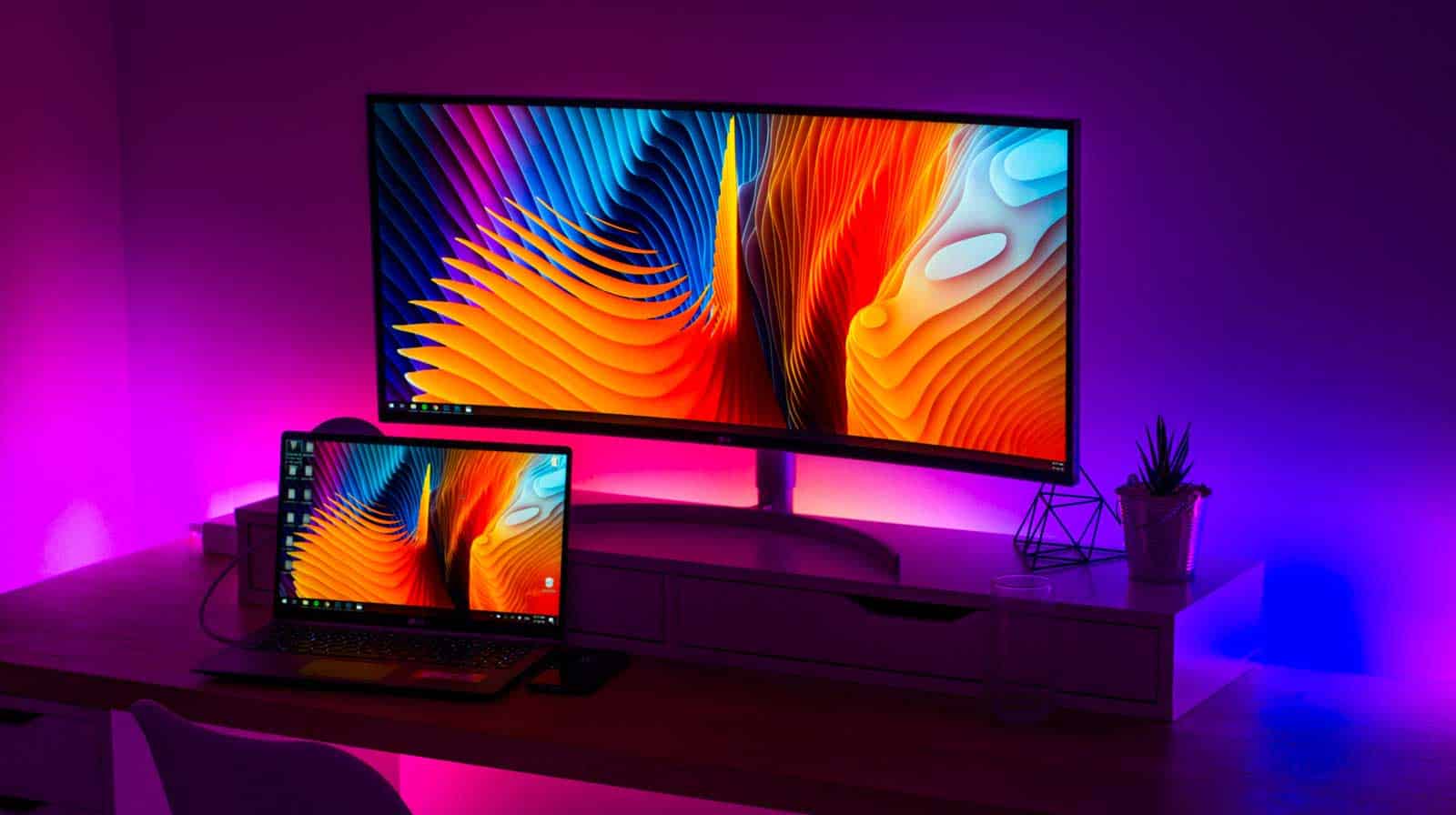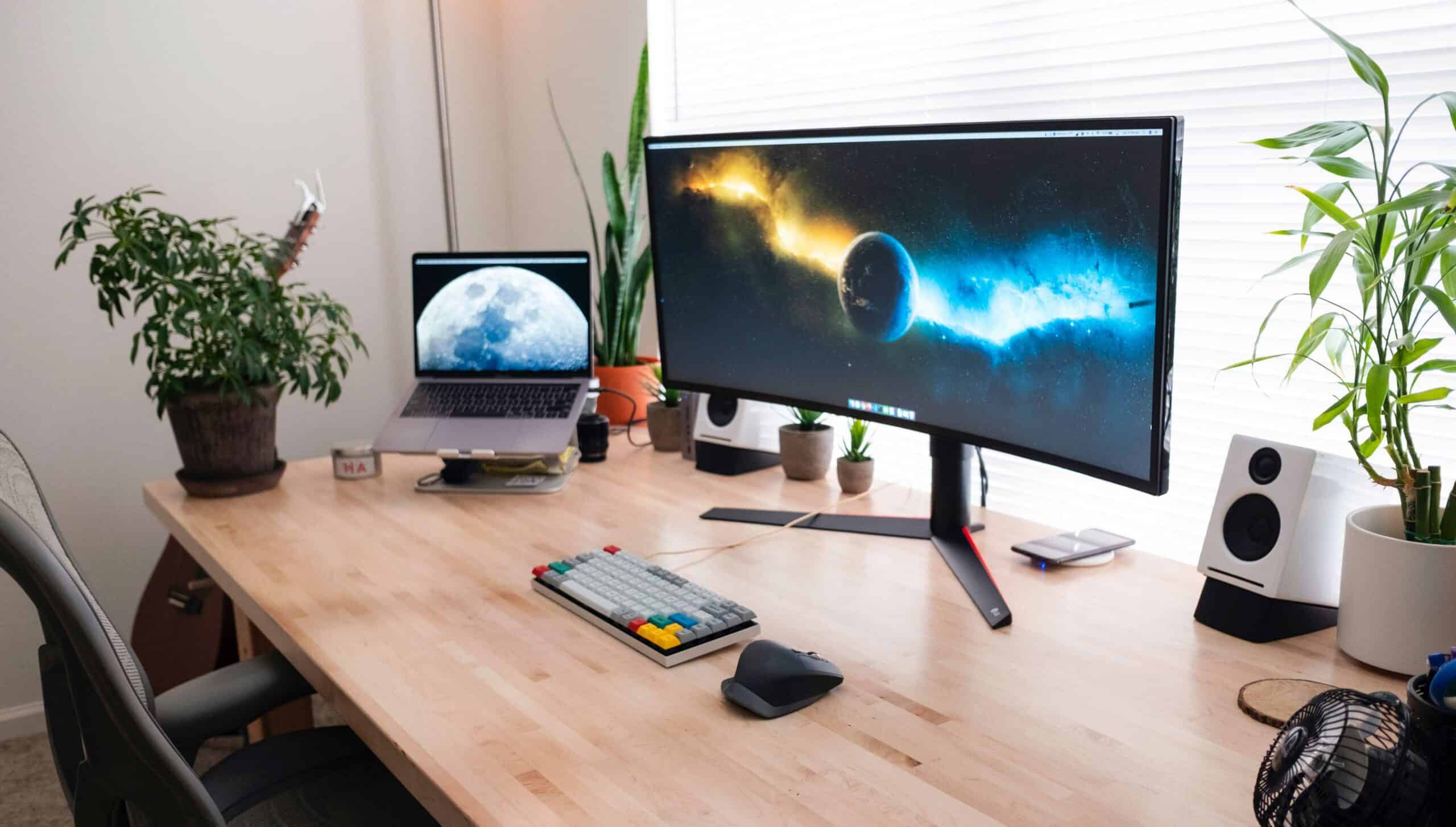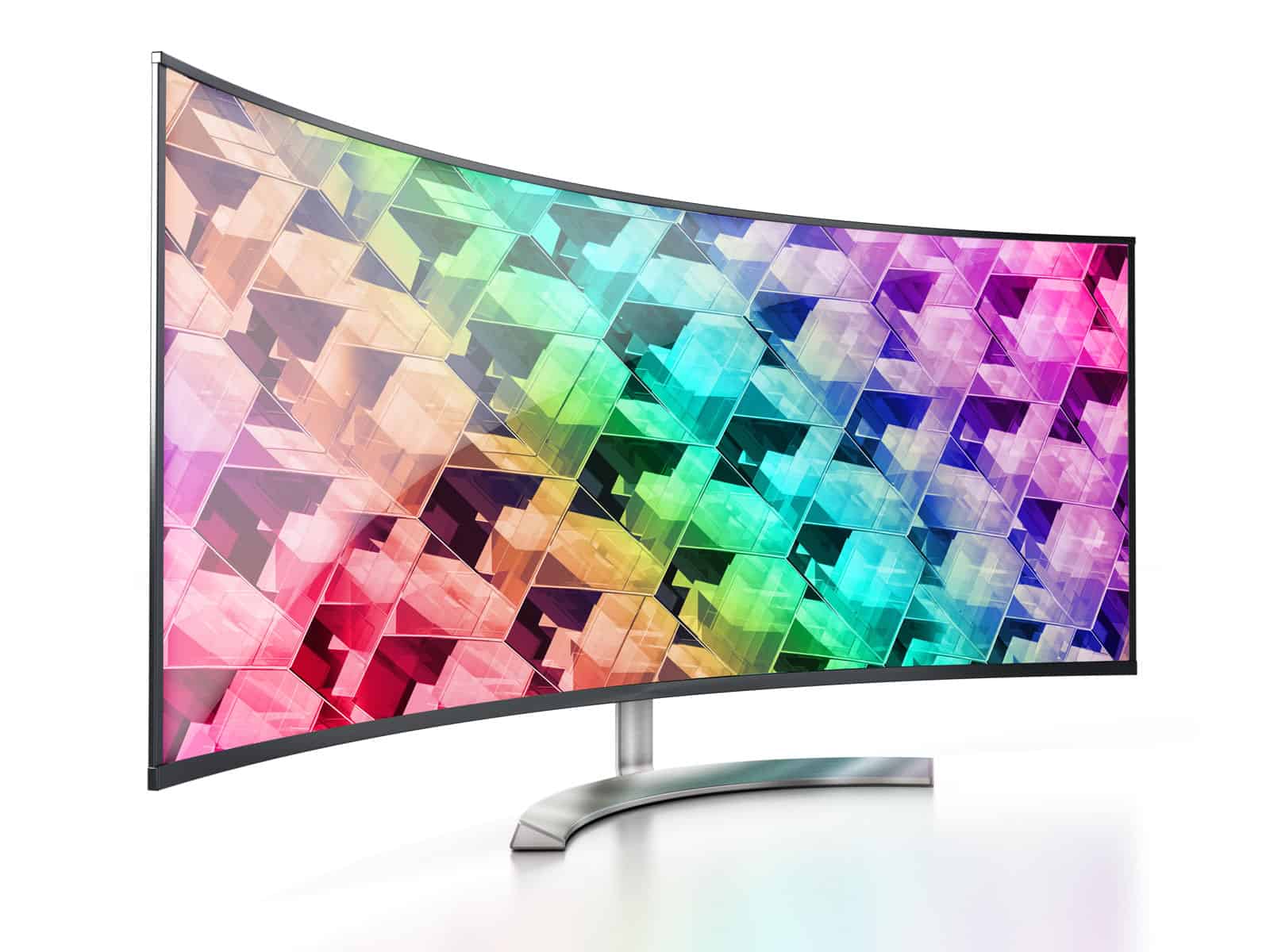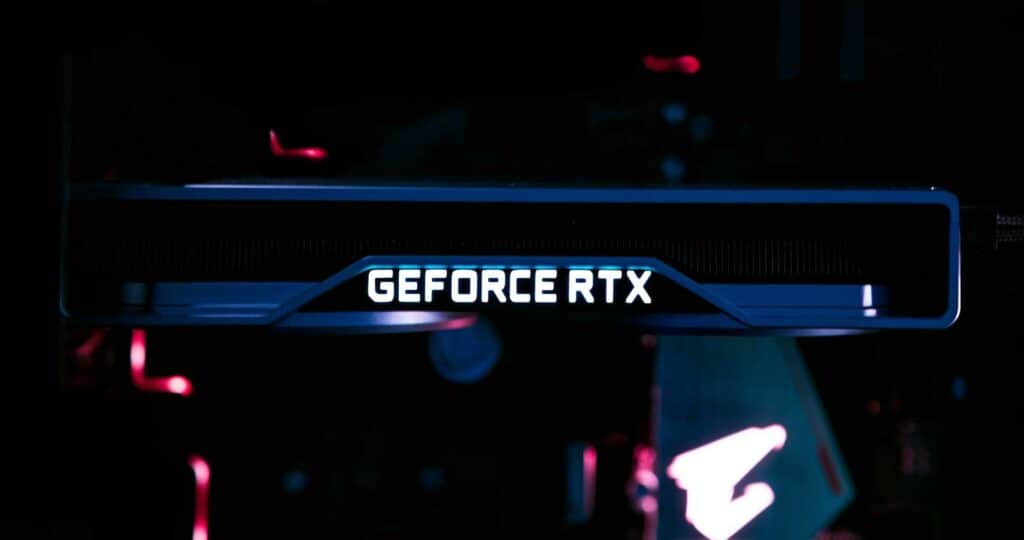More pixels mean more power is needed from a GPU or graphics card. If you are planning on using an ultrawide monitor setup for your PC or laptop to replace your standard monitor, you are going to need a better graphics card to maximize the use of your screen space — whether it is a gaming monitor or ultrawide screen for working, editing, and other uses.
Here are the best graphics cards cards for ultrawide monitors:
| Radeon RX 6600 XT | NVIDIA GeForce RTX 3080 | XFX RX 5700 XT Thicc III Ultra |
|---|---|---|
| Supports up to 1080p resolution | Supports up to 4K resolution & high refresh rate | Supports up to 4k resolution and 1044 ultra-wide gaming |
| 2.8 GHz Boost Clock Speed | 1.71 GHz Boost Clock Speed | 1925 MHz boost clock and 1815 MHz game clock |
| 8GB RAM | 10 GB memory | 8GB RAM |
| Check prices & learn more | Check prices & learn more | Check prices & learn more |
If the ultrawide resolutions are too high for your GPU, you will notice the difference between the frame rate and refresh rate when dragging, minimizing, and maximizing open windows and other performance issues. If that is the case, no matter what the screen size is, you are going to run into problems if you don’t have the appropriate graphics card.
- So do you really need a special graphics card for an ultrawide monitor?
- What should you need to look for in a graphics card?
- Why you would regret buying a cheap graphics card for an ultrawide monitor
Real quick, before we get too far into it here, if you want to get more great ideas for your gaming room or home office and want to connect with other home office hackers to make your space the best join my free private Facebook group, Home Office Hacks here.
Do you need a special graphics card for an ultrawide monitor?

Every computer needs a graphics card to run any monitor. But for monitors with higher resolutions and a higher number of pixels, you are going to need a better graphics card that can support it. Some GPUs have higher RAM (random access memory), which makes them better for fast frames per second.
Also, you can consider a higher boost clock — which works kind of like a fan. The boost clock automatically increases the speed of a graphics card to provide high performance under heavy load, which makes GPUs with a higher boost clock rate work better for gaming and other uses.
See this table to help you find the right GPU for the widescreen monitor you are planning on buying:
| Screen Resolution | Number of Pixels | Refresh Rate | GPU RAM |
| 1920 x 1080 | 2,073,600 | 600MHz | 4 GB or higher |
| 3440 x 1440 | 4,953.600 | 1000MHz or higher | 6 GB or higher |
| 3840 x 2150 | 8,294,400 | 1800MHz | 8 GB or higher |
Aside from the amount of RAM or random access memory, another factor that can affect GPU is the type of RAM. Here are the different types of GPU RAM that you will encounter and you will need for ultra-high-definition wide monitors:
| RAM Type | Description |
|---|---|
| DDR3 SDRAM | This type of video RAM is also known as the double data rate 3 synchronous dynamic random access memory. It is a type of graphics card memory that most somewhat older computers use. Although with a higher memory, it could work with ultra-wide monitors– but it is not gonna be enough to give you the best experience. |
| GDDR5 | Graphics double data rate type five synchronous dynamic random access memory or simply, GDDR5 is a more advanced type of RAM, which can support higher screen resolutions. It is also smaller and it produces less heat despite its power and excellent performance. If you are looking for a GPU that might have the capacity to support wider screens in high definition, make sure you start by checking the type of RAM. |
| GDDR5X | This type of video RAM is the latest version of the GDDR5 SDRAM. It was standardized in 2015 and it doubles the current rate of GDDR5 RAMs, making it a more flexible choice if you want a monitor that goes up to 4k resolution. |
| GDDR6 | This SGRAM type is specifically developed for high-end computers with higher screen resolutions. Choosing this type of RAM for a GPU is one of the best options for gaming and other high-resolution uses for your monitor. |
| HBM and HBM2 | Although high bandwidth memory random access memory or HBM video RAMs seem quite overkill even for gaming, many users spend the extra cash just to get the best experience possible with a GPU of this high quality. It is made for advanced computer systems and any computer built with an HBM GPU can be considered a supercomputer. This massive memory bandwidth can go way past what a GDDR5 and GDDR6 RAM could ever achieve in terms of power and performance. However, its high bandwidth makes this type of RAM slower than GDDR5s, which is not ideal for some uses. |
What do you need in a graphics card for a new ultrawide monitor?

To put it simply, Wide QHD (WQHD) requires 35% more processing power than standard 1440p resolution. This means that if you want to maintain the same frame rate, you need a video card that can handle the extra load. Of course, this all depends on whether or not your video card has enough RAM to support the larger screen size in whatever game you’re playing – if it doesn’t, performance will suffer even further.
The greater the monitor resolution, the more intensively your GPU has to work to display things at native resolution. So a 4k monitor is tougher than an ultrawide 1600p, which is tougher than a 1440p ultrawide, and so forth. You can find out how tough it is for your GPU by taking the resolution and multiplying the two numbers together to get pixel count (for example 1920×1080). The higher that number is, then harder your GPU will have to struggle.
There are some games with high CPU usage that run noticeably slower on 21:9 aspect ratios than 16:9.
For example, in a single-threaded MMO, 3840 x 2160 performed 13% better than 3440 x 1440.
Also, you wouldn’t be able to see this difference in reviews or benchmarks because they test GPUs under GPU-bound scenarios and CPUs at low resolutions like 720p or 1080p which use the 16:9 aspect ratio.
When buying a computer, too many people go with the cheapest option available. But not everyone needs the latest and greatest technology. In fact, many people would rather spend less money and buy something that works well enough.
But there are times when you need to spend the money to get the latest technology so you can get the best performance. For example, if you’re going to play games online, you might as well get the fastest graphics card possible. Or maybe you’re planning on making videos or editing photos.
If you’re wondering whether you need a high end graphics card, read on. I’ll explain why you may not need a high end GPU and how you can save yourself from spending hundreds of dollars on a graphics card you won’t even use.
Things to consider when buying a GPU to run your ultrawide monitor

If you decided that you are going to need to upgrade your computer’s GPU, here are some things you might want to consider before picking one up off the shelf:
Consider your CPU
Before getting the best GPU in the market, you might want to consider if your CPU can handle it. The best GPUs in the market are way advanced for CPUs with an i5 processor or lower. So if you are considering upgrading to a GPU that can handle an ultrawide monitor, also consider upgrading to a better processor to experience the best for working, watching, and gaming.
Higher Refresh Rate
Refresh rate is the number of times per second the monitor displays a new image, which is measured by MHz. If your monitor tops out at 1080p,
Many people interchange refresh rate with frame rate, but it is, in fact, independent from frame rate. When choosing the best GPU to go with your wide monitor, make sure you get one with a higher refresh rate to reduce flickering which can cause eye strain. If you ever tried taking a photo of your computer screen using your phone camera and the monitor flickers too much, that means the GPU and monitor have a low refresh rate.
Consider the purpose
If you are buying a GPU that is compatible with your ultrawide screen monitor for gaming, then you should just match the specs of the widescreen monitor you want to buy. 1080p resolution only needs a 60Hz GPU to run, meaning you don’t have to get anything higher than that.
Consider space and power
Before buying a GPU, make sure you have enough space in your PC case and make sure your power supply has enough watts to spare for the graphics card you are considering. If you are considering getting a dual graphics card, we are going to stop you right here because they are not really worth the extra money. If you want to save money, just consider getting the best GPU you can afford.
Consider your budget
As we mentioned before, your graphics card should be compatible with your CPU, meaning you may want to consider your budget since you might be upgrading your CPU as well. If you blow your budget on the best GPU, you might not have enough money to spend on a CPU upgrade– especially if you are on a tight budget.
3 best gpus for gaming and everything else
Now that you understand what type of GPU you should be getting for your ultra-wide monitor, here are some of our top recommendations.
PNY GeForce RTX™ 3080 10GB XLR8 Gaming Revel Epic-X RGB™ Triple Fan Graphics Card LHR
- NVIDIA Ampere architecture, with 1440MHz core clock and 1710MHz boost clock speeds to help meet the needs of demanding games.
- 10GB GDDR6X (320-bit) on-board memory, plus 8704 CUDA processing cores and up to 760GB/sec of memory bandwidth provide the memory needed to create striking visual realism.
If you are looking for something that can handle ultra-HD games at a higher frame rate, this GPU is one of the best options. It has over 150 top gaming applications and supports up to 107 frames per second– it can’t get any better than that.
And if that’s not enough, it comes with a high refresh rate with a fast boost clock speed for almost any application. However, this graphic card is quite on the higher-end. But if you have a widescreen monitor you want to maximize, this option is one of your best choices. Note that this GPU is created for gaming, so if you are just using your PC for watching movies or doing any work that does not rely on high-quality graphics– you shouldn’t spend too much money on something like this.
ASUS ROG Strix AMD Radeon RX 6600 XT OC Edition Gaming Graphics Card (AMD RDNA 2, PCIe 4.0, 8GB GDDR6, HDMI 2.1, DisplayPort 1.4a, Axial-tech Fan Design, Super Alloy Power II, GPU Tweak II)
- Memory Speed:16 Gbps.Digital Max Resolution:7680 x 4320
- Axial-tech Fan Design features a smaller fan hub that facilitates longer blades and a barrier ring that increases downward air pressure.
If you are looking for the best budget option that supports 1044 gaming and 1080p resolution, this GPU is an excellent choice. Although it has only 8GB of ram compared to the 10GB from the RTX 3080, it is equipped with GDDR6 RAM that can handle higher screen resolutions and a 21:9 aspect ratio from wide monitors.
Although it does not support 4K resolution, it is reasonable for its high boost clock speed and high refresh rate. However, we would not recommend it for gaming, but it is good enough for photo editing and watching HD videos.
XFX RX 5700 Xt Thicc III Ultra 8GB Boost Up to 2025MHz GDDR6 3xDP HDMI Graphics Card (Rx-57XT8TBD8)
- Introducing the new XFX thicc III ultra 5700 XT. Built with style and dynamic cooling power in mind to yield lower temperatures and heightened performance that adapt to the intensity of the moment.
- Get the very best FPS the 5700 XT series can deliver. Thanks to the 2.90 millimeter fans and 100 millimeter fan, the thicc III ultra stays cool and quiet, allowing you to achieve higher boost clocks.
If you want to play any ultra-wide game, this GPU is the option for you. Made specifically for gaming, this graphics card is equipped with a high base clock, game clock, and boost clock for other data-heavy applications.
This graphics card has been around for a while, but it was released ahead of its time and the technology is still more relevant today more than ever.
Why do you need an ultrawide monitor?
Ultra-wide screens have many uses, especially if you do a lot of work on your computer. With multiple tabs open for editing, recording, and other applications, the extra horizontal space will enable you to multitask and be more productive compared to normal monitors. Note that not only do ultra-wide monitors provide more screen real estate, but they also provide more vivid details depending on their resolution.
Many gamers also use an ultrawide gaming monitor for their setup because they can make use of their peripheral vision, which can help them have a better advantage over their opponents. Here are some of the benefits of getting one for your computer setup:
Great for ultrawide games
Whether you are playing games on your PC or using a game console, having a larger monitor with extra space can make your experience a lot better. With your peripheral vision, you can look at most of the parts of the screen, especially if you chose a curved larger screen with a higher screen resolution. Whether you are playing racing games or first-person shooters, a larger single display, compared to dual monitors is much better– giving you a truly immersive experience.
The best visual experience
Whether you are reading, writing, working, looking at photos, etc., it is better with a monitor with high resolution and a larger display. Some ultra-wide monitors allow you to set them up horizontally or vertically, depending on your needs.
The best cinematic experience
Nowadays, only a few people watch movies and series on their TVs. If you want to experience the same movie experience on your computer, make sure you get wide curved displays to experience home-theater quality on your computer. But remember, without a GPU to support the 4k monitor resolution, it will all be for nothing and you wouldn’t be able to enjoy the full potential of such a large screen.
Do ultrawide monitors affect cpu performance?

An ultrawide monitor can affect CPU performance, but one of the most common solutions to lessen the impact on the FPS is by upgrading your GPU. As a rule of thumb, you might want to remember that refresh rates indicate how many FPS a monitor can display. If you have been using an older PC with at least 4GB of RAM for processing, you can upgrade to a GDDR5 8GB GPU to enjoy an ultrawide monitor for watching movies on your computer.
As for gaming, A dual-core 4GB RAM processor won’t be the most ideal even if you get a GPU upgrade. The processor works hand in hand with the graphics card, so make sure you upgrade both CPU and GPU to ensure the best gaming experience.
Related question: what is an ultrawide monitor?
Ultrawide monitors, from the name itself, are monitors that are wider than usual. To put it into technical terms, ultra-wide monitors utilize a 21:9 aspect ratio compared to traditional monitors that use a 16:9 aspect ratio.
A 21:9 aspect ratio is similar to the display of traditional movie theater screens, which is why ultra-wide monitors can give you the ultimate cinema experience as well as ultrawide gaming— thanks to the extra horizontal space.
Next Steps
Want to connect with other gamers and people who work from home who are creating the most amazing home offices and get more tips, tricks and hacks on how to make your home office or gaming room setup the best it can be?
Join my brand new free private Facebook group, Home Office Hacks to connect with other home office hackers to make your space the best!



